The restoration of interior doors allows you to save resources on purchasing a new design and to make the canvas corresponding to the renovated interior. The list of repair measures is determined by the condition of the product at the moment and the goals pursued.
The need to restore interior doors
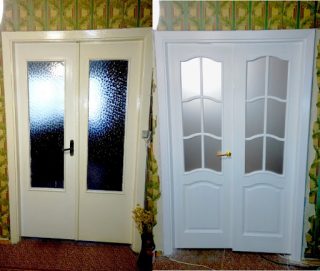
During operation, the door leaf and frame wear out. Defects of a mechanical or environmental (for example, associated with high humidity) nature appear on them. In the process of using the structure, a lock, hinge or other hardware element may break. In this case, they require replacement.
Among the main types of damage to the canvas itself, in which the restoration of doors is required, one can single out:
- Mechanical damage that appears when trying to open the door using improvised items. In this situation, it may be necessary to update the jamb, seal cracks with putty, and paint the surface. In case of significant damage, the blade must be replaced.
- Cracking due to wood drying out. Do-it-yourself restoration of interior doors in this case is carried out at the initial stage of the destruction process.
- Peeling of panels, film or other coating with which the canvas is finished.
- Peeling paintwork. If it does not have a dotted character (sufficient area is damaged), you must first remove the old paint.
Sometimes during operation, redundancy in the dimensions of technological gaps is detected. This situation can lead to drafts. In this case, it is possible to sheathe the structure with a material, the thickness of which is sufficient to bring the clearances closer to the desired values.
Feasibility of the procedure
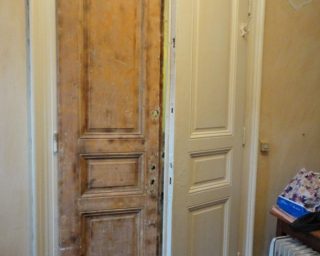
Before starting the restoration of the canvas, you need to assess what will be more profitable from the point of view of operation in the long term - to restore or replace. If the task is to change the design decision, it's easy to do it yourself. Usually it is chosen to match the interior of one or both rooms, which are separated by the structure.
The restoration of old doors is advisable, provided that changes in the thickness of the leaf are at an initial stage. If the damage has gone far, the best solution is to completely replace the product. Examples include material decay due to condensation, moist air or regular water ingress. If rot or fungus has covered a small area, it must be completely removed and then tackled with a decorative coating. But if the lesion has a large area, the door will have to be replaced.
If there are large chips or depressions, it is also better to put a new blade. If you try to restore such a structure, you will have to remove a large layer of material, which will make it thinner.
Required tools and materials
Before you repair the door, you need to prepare the tools. To level the surface, a grinder and different types of sandpaper are used. If you need to remove old paint, you need a hair dryer and a spatula.The hot environment softens the composition, which is then removed from the surface. It is not recommended to use chemical washes - they can damage the structure of the array.
Special mixtures are used to seal cracks. They are available in a wide range of shades, so you can choose the composition to match the finish of the canvas. For small cracks, epoxy and special waxes are also suitable. When working with them, you need to ensure that substances do not fall on the canvas itself. Otherwise, there is a high probability that after staining the surface will be bumpy.
Preparatory work
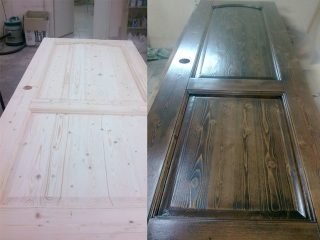
After removing the door from its hinges, the first step is to remove the old coating. If the canvas was finished with facing material, it can be removed in whole or in part - it all depends on the degree of damage and what it is planned to cover the door with as a result. Locking structures, handles must be removed. If there are glass inserts in the structure, they are also dismantled. After that, an inspection of the box and platbands is carried out. Worn out structural elements must be replaced.
Door processing begins with dust removal and surface grinding. Then they move on to sealing cracks and similar minor damages. If a putty was used for this, you need to wait for it to dry and then sand the surface with sandpaper.
The cloth is impregnated with an antiseptic composition in two steps. If it is decided to use a paint and varnish composition, the surface must first be primed.
For the restoration of solid wood doors, staining is well suited. It emphasizes the texture of the material well. On sale you can find compositions that imitate valuable tree species.
Methods for the restoration of interior doors
You can give the door a presentable look using different techniques and materials: applying a paint and varnish composition, sheathing with decorative coatings, using a mosaic.
Painting
Painting wooden doors is one of the simplest and most popular restoration methods. The main thing is to choose a quality composition of a suitable tone. Acrylic paints have the best indicators of environmental safety. They do not have a pronounced odor, are available in a wide palette of tones, and give a smooth matte surface. Also, for this type of work, alkyd compounds or nitroenamel can be used, but during the staining process with these products, a strong odor will be emitted. It will disappear when the applied layer is dry. If possible, it is worth painting the dismantled door on the street.
After the acrylic composition has dried, the canvas can be coated with furniture varnish. This will allow the paint to last longer. It is applied with a brush or roller, depending on the shape and design of the door. To prevent the loss of lint, the brush is kept in water for 3-5 hours, and then combed. Sometimes varnish is used without the use of paint, applying it over a layer of stain or covering the primed surface of the door.
Pasting
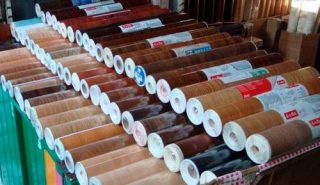
You can sheathe the canvas with different types of materials. Natural veneer gives the most noble look. It can also be used for finishing structures made of MDF or chipboard. Before work, the door leaf removed from the hinges is placed on stools. The process starts from the central part of the canvas. A fragment of the surface is covered with glue, a veneer is placed on top, pressed first with your hands, and then with a roller. To achieve maximum reliability of the connection, the plane is treated with a construction hairdryer, after which it is again passed with a roller. When the entire canvas is sheathed, the glue is allowed to dry to the end. After that, it can be varnished.
Also, for the exterior decoration of door structures, a self-adhesive film with imitation of wood is used. Its use will help hide small surface defects. The cutting of the film coating is performed with a knife. From the inside, remove the protective layer a few centimeters from the top.The film is placed on the canvas and ironed with a rubber spatula or rag. Then, gently continue to remove the protective covering. If air bubbles appear under it, they must be removed immediately. When the canvas is covered, the film is cut off and the fittings are mounted.
Among other options for materials that can be used to paste over the door, it is worth mentioning blanks made of vinyl with photo printing or photo wallpaper. The latter must be washable, since during operation the product is periodically exposed to moisture and becomes dirty.
Before work, you need to adjust the material cuts to the dimensions of the canvas. PVA glue is suitable for fixing. They lubricate the door structure, press the finish, iron it and level it.
Decoupage
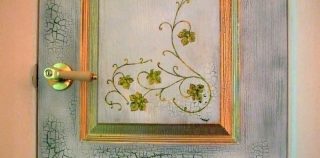
This option is good for its simplicity - for its implementation, it is not even necessary to remove the canvas from the hinges (if it does not have the old finish to be dismantled). The surface is pre-washed, dried and primed. The opening is glued with adhesive tape. The decoupage card is soaked in water for several minutes in advance (the duration is indicated on the package). Then excess water and protective strips are removed from it. The ornament is applied to the canvas on which PVA glue is applied. The surface must be leveled and air bubbles removed. When everything is completely dry, you can varnish the door with acrylic.
Stained glass decoration
For implementation, you will need to prepare a sketch of the drawing, as well as brushes, a marker and paints for the stained-glass window. On the dismantled door (or the glass insert removed from it), the contours of all the elements of the pattern are drawn from the seamy side of the glass. From the face, the contours are covered with paints. When they are dry, the bounded blocks are filled with the desired colors. While the paints are not frozen, colored glass, stones and other decorations can be glued to the surface. After complete drying, the structure can be put in place.








